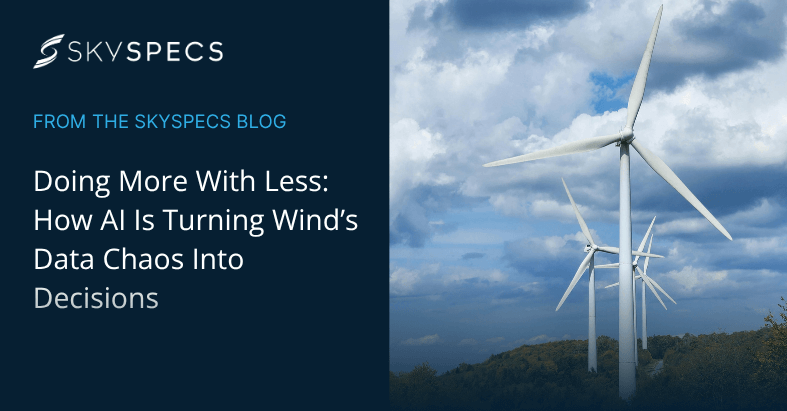Doing More With Less: How AI Is Turning Wind’s Data Chaos Into Decisions
Across the wind industry, one phrase keeps popping up in conversations with operators:
We have to do more with less.
Teams are smaller, fleets are aging and incentives are shifting. At the same time, owners are asked to increase production, reduce risk and stretch every maintenance dollar.
The data exists to help do that. The problem is not a lack of data. It is that most organizations are stuck in what SkySpecs calls data chaos – huge volumes of information with no practical way to turn it into trusted decisions.
This blog, based on a recent SkySpecs webinar, explores how AI and tech enabled insights can change that.
The Data Dilemma
Most operators are sitting on a pile of disconnected data:
- Blade inspection photos
- CMS vibration signals
- SCADA performance data
- Lightning strike information
- Repair and inspection reports, often as PDFs
- Financial and life extension models
Individually, each source is useful. Together, unmanaged, they become overwhelming.
Common symptoms of data chaos:
- Terabytes of data that no one has time to analyze
- Giant Excel files that only one person truly understands
- Inconsistent formats and missing metadata
- Engineering teams that are stuck reacting instead of planning
You end up with analysis paralysis. You know there are answers in the data, but you cannot get to them in time to matter.
Why Spreadsheets Are No Longer Enough
Spreadsheets are great for a single project or a small dataset. They are not built for:
- Millions of images
- Years of high frequency vibration data
- Cross referencing CMS, SCADA, inspection, lightning and financial data
- Turnover on your team
When the one engineer who built the spreadsheet leaves, so does the logic. And even the best spreadsheet cannot scale to the global data volumes that AI thrives on.
To move from local, manual analysis to fleet level decision making, operators need two things:
- A unified data foundation rather than silos.
- Automation and AI to process, clean and interpret data at scale.
What Tech Enabled Insights Really Means
“Tech enabled insights” is more than a dashboard or a buzzword. In the context of SkySpecs, it means:
- A massive, unified dataset
- Tens of thousands of inspections every year
- Millions of recorded blade damages
- Decades worth of aggregated vibration data
- Tens of thousands of inspections every year
- AI models that:
- Detect and classify blade damage
- Process and normalize CMS data from multiple OEMs
- Extract structured information from PDF repair reports
- Link events across systems, such as lightning, CMS anomalies and visual findings
- Detect and classify blade damage
- Engineering and financial experts who sit on top of that stack and help operators decide what to do next
The result is not “AI instead of people.” It is AI plus specialists who effectively become an extension of the operator’s own team.
Clean Data First, Smart Decisions Second
Every impressive AI outcome starts with boring work: getting the data right.
SkySpecs ingests:
- Native inspection data from its own operations
- Third party inspections from other providers
- CMS and SCADA data from different turbine OEMs
- Blade and drivetrain repair reports
- Lightning and environmental data
AI is used to:
- Standardize and enrich metadata on images and events
- Pull key fields out of unstructured PDFs
- Reformat data into a common model, regardless of its source
- Automatically flag issues in reports, images and time series
One practical example from the webinar:
- A customer had around 150 repair reports with roughly 4,000 images.
- A SkySpecs team member noticed some images looked repeated.
- Manually comparing all images would have required millions of comparisons.
SkySpecs built a tool that:
- Automatically compares images and finds likely duplicates.
- Flags those cases for a project manager to review.
This allowed the operator to verify that repairs were properly documented and delivered, without burning weeks of engineering time.
Human In The Loop: Building Trust in AI
Industrial AI is only useful if engineers and asset managers trust it enough to act on it.
Good models are robust, not perfect. In fact, a model that appears 100 percent accurate is usually overfitted or biased. For real assets, the goal is:
- High accuracy (for example in the 90 to 95 percent range)
- Strong generalization to new turbines, sites and conditions
- A clear place for human review on the most critical decisions
SkySpecs bakes human in the loop into its approach:
- AI and automation handle volume, pattern recognition and consistency.
- Blade and CMS experts validate the outputs and tune recommendations.
- Operators provide site reality, such as specific constraints, past experience and risk preferences.
This combination keeps AI fast and scalable while keeping people in control.
Real World Impact: From Failures to Prioritized Action
Two examples from the webinar show how this plays out in practice.
1. Prioritizing Repairs Instead of “Fix Everything”
One operator’s default strategy was to repair every Category 5 blade defect. That sounds conservative, but budgets are limited and not every Cat 5 is equal in real risk.
With tech enabled insights, SkySpecs helped:
- Analyze damage in the context of blade make, model and location
- Identify which damages were most likely to propagate quickly
- Highlight some lower category damages that were more urgent than certain Cat 5s
Result:
The operator focused repair spend where it most reduced risk, instead of treating all severe defects the same.
2. Turning Around a Farm With Multiple Turbine Losses
Another operator had experienced four full turbine losses in a year. When SkySpecs came in:
- Inspections revealed a large number of Cat 5, 4, 3 and 2 issues.
- The budget could not possibly cover every defect.
Using AI and engineering expertise, SkySpecs worked with the operator to:
- Rank defects based on failure risk, progression history and cost impact.
- Build a repair plan that fit the existing budget.
The reported outcome so far:
In the following year, with similar spend but smarter prioritization, the operator had no turbine losses.
What This Unlocks For Operators
Moving away from data chaos toward tech enabled insights allows operators to:
- Use limited budgets on the highest impact repairs.
- Catch problems earlier instead of paying for catastrophic failures later.
- Reduce dependence on single spreadsheets and single experts.
- Tie engineering decisions directly to financial outcomes.
- Benchmark their fleet against a much larger, global dataset instead of guessing.
In a world where wind assets are competing not just with other wind, but with oil, gas and other generation sources, efficiency and reliability are strategic advantages.
The data is already there. The opportunity lies in turning it from a burden into a decision engine. AI, combined with experienced engineers and a unified platform, is how the industry gets there.
Interested in chatting with us further about how SkySpecs uses AI for our customers? Reach out through the button below:



